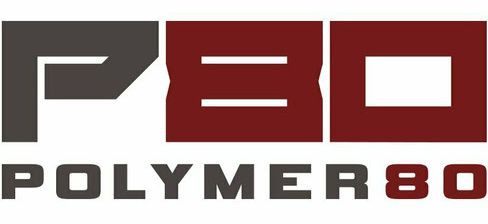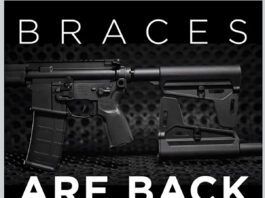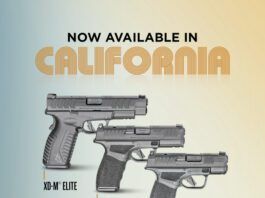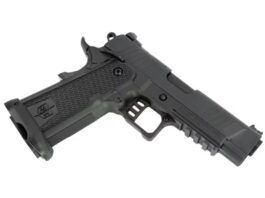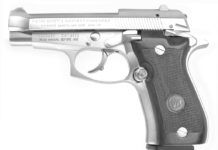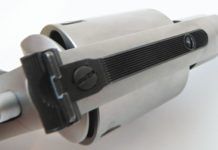Apex Announces New Flat-Faced Action Enhancement Trigger for Sig Sauer P320
Apex Tactical Specialties has announced its new Apex Flat-Faced Action Enhancement Trigger, about $45, for the popular SIG Sauer P320 series of pistols.
Magnum Research Desert Eagle Animal Prints
Magnum Research Introduces New Animal Prints on Desert Eagles
Following the success of its Cheetah print for the Desert Eagle, Magnum Research has introduced two new prints — the Kryptek Highlander and the Snakeskin, available in either .50 AE or .44 Mag.
SIG Sauer 1911 C3 45 ACP
In a Bargain Hunter feature in the July 2014 issue, Contributing Editor Bob Campbell examined whether it was better to buy a quality used handgun or a new economy handgun.
STI DVC Pistols
STI's new DVC Limited and Open pistols are an entirely new design based off the 2011 platform and are built specifically for competitive shooting, such as 3-Gun, U.S.P.S.A., or I.P.S.C.
[VIDCAP(1)]
Kel-Tec PMR 30 Review
When Kel-Tec CNC Industries brought out its PMR-30 semi-auto pistol chambered in 22 Winchester Magnum Rimfire, we immediately wanted to compare it to FN's 5.7, a much more expensive handgun. Also, the FiveSeven was chambered in 5.7x28mm, a much more expensive and hard to find round.
FN 5.7 Handgun Review
In an intriguing and extensive match-up in the December 2014 issue, Gun Tests Magazine pitted two handguns chambered for hot 22-caliber bottlenecks against each other. The 22 TCM and the 5.7x28mm cartridges are interesting on many levels, but also are not the most common or easily obtained rounds. Both handguns have a military heritage, but the Rock Island 1911 is pretty far removed from its 1911A1 45 ACP ancestor.
(Gunsmithing Pistols and Revolvers #4) Cold Blue
Cold bluing, or chemical bluing, is used to touch-up slightly worn or nicked blued finishes. It is suitable for covering up the holster wear on the muzzle of a revolver, or a spot on a slide where your sweat lifted the blue. It is not nearly as durable as a hot-dip blue finish. Some cold-blue formulas contain sulfides, and a handgun that has been touched-up too much can have a very alight, but noticeable, smell of rotten eggs. Sniffing a used firearm, to see if there has been any use of cold blue to hide wear, is an old trick in the gun business.
(Gunsmithing Pistols and Revolvers #5) Reassembly Tips – Smith & Wesson
When putting an S & W revolver back together, a few steps seem to cause more trouble than the rest. One is the insertion of the cylinder-locking bolt, and its spring, into the frame. The bolt has to go down its shaft, while the spring has to be squirmed back into the tunnel drilled into the front of the frame cutout. (I have no idea how they drill that hole.) With the frame resting on a padded surface, place the spring into its hole in the locking bolt. Start the bolt partway down the shaft until the spring bears against the edge of the frame. Use a small eyeglass screwdriver to compress the spring enough to clear the edge of the frame and push the bolt and spring down the shaft. When you get to the frame hole, the spring will snap into place. Be sure the bolt is completely down the shaft, and pivots smoothly up and down through the cutout under the cylinder.
GUNS, GUNS, AND MORE GUNS
Dury's Gun Shop, which supplies FFL services and guns for Gun Tests Contributing Editor Ralph Winingham in San Antonio, has partnered with Tom Gresham of Gun Talk Radio to create a limited run of 1,000 GT20 pistols, which are SIG Sauer P220 10mm handguns. Price is $1400. All GT20s will come with a SIG Sauer hard case and two eight-round magazines. Additional accessories can be purchased from Dury's and shipped directly to you with the purchase of your one-of-a-kind GT20 pistol. Shipping will only be $25 for the GT20 and free for all additional accessories ordered.
Beretta Cheetah 84 LS .380 ACP, $652
Smaller guns have always had a certain appeal. In some cases it was just the aspect of miniaturization that captures our imagination. In other cases it was the reassurance of a highly concealable weapon. One niche of such guns were semi-auto .380s, which have long been popular sidearms because of their flat, short footprint and sufficient, if not outstanding, power. Even in the small world of 9mm Shorts there is a pecking order in terms of size, with the Beretta 84LS being one of the largest.
Big-Bore Snubnose Revolvers In 44 Magnum and 41 Magnum
To make an S&W N-Frame revolver into a compact carry gun means reducing the revolvers barrel length and grip. Whats left is still a large frame and cylinder that holds six cartridges. It is big metal, compared to an S&W J-frame, Ruger, or Taurus compact revolver normally used for concealed carry. The N-frame is renowned for its strength and has three safety features built into the mechanism: a hammer block, rebounding hammer, and hammer stop. All three safety features work unseen inside the frame and under the sideplate and make the revolvers very safe, guarding against accidental discharge from being dropped on a hard surface or a hammer slipping out from under a thumb. All of the N-frames tested were derived from the classic S&W Model 29.
The Model 29, along with the 44 Magnum cartridge, debuted in 1955 due to Elmer Keith arm twisting and convincing Smith & Wesson that shooters needed a more powerful revolver cartridge. Keith was a gun writer, outdoorsman, and big-bore revolver aficionado who hand-loaded the 44 Special to its maximum potential. His theory was to push heavy bullets at high velocity. Bullets designed by Keith, often referred to as Keith-style semi-wadcutters, feature a wide nose and convex sides. They also allow more powder to be loaded into the case. These bullets, when loaded properly, are a benchmark in power and penetration. We actually tested some Keith-style bullets loaded by Buffalo Bore for this report.
Keith had tremendous input on developing magnum cartridges for revolvers and also had his hands in the development of the 41 Magnum, which was introduced in 1963 as a cartridge to bridge the gap between the 357 Magnum and 44 Magnum. The 41 Magnum has more power than the 357 and less recoil than the 44 and was designed with law enforcement in mind, though it did not have a big impact on the LE market. Hunters, however, found the cartridge was plenty powerful for medium-size game, including black bear. The 41 Magnum is similar to the 16-gauge shotgun in terms of compromising power and recoil as well as popularity. Both have strong but small followings, and in the 41 Magnum we can see why from our range sessions.
Since its introduction, the Model 29 has gone through numerous design changes that are reflected in the - model names found in these variants model numbers. Stainless-steel models have a 6 prefix in the model number; those built from scandium alloy have a 3 prefix in the model number.
If carrying around a huge revolver for everyday concealed carry literally sounds like a pain in the hip, consider this: For everyday carry, Keith wore a Model 29 with a 4- or 5-inch barrel. He was a man of small stature but great influence. Before Hollywood discovered the Model 29 and made Clint Eastwoods Dirty Harry character synonymous with the big bore, long barrel revolver, Keith lived it. Eastwood played it.
To live it means to carry it, and that is what we did with the four revolvers in this test. They are all six-shooters, have 2- or 3-inch barrels, small compact grips - except for one model - and are chambered in bone-bashing 44 Magnum or 41 Magnum. Real power, real recoil. Not for the faint of heart nor faint of recoil. If Elmer and Harry can carry around long-barrel variants, we figured these compact versions would be easier and more convenient for concealed carry. After shooting, with hand palms aching and lots of big holes in the targets, the team felt one model would really make your day, offering a good combination of features in a big-bore compact revolver for daily concealed carry.
Prior to testing, we ran Brownells revolver range rods (080-617-044WB, Rod Combo for .44/44 Mag., $40; 080-617-041WB, Rod Combo for .41, $40) down the bore of each revolver to check chamber alignment. We checked the gap between rear of cylinder with Brownells Go/No Go 60/68 Cylinder Gauge (080-633-668WB, $36). We assumed that since these were new or LNIB, they would pass and they did.

























